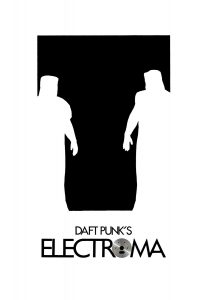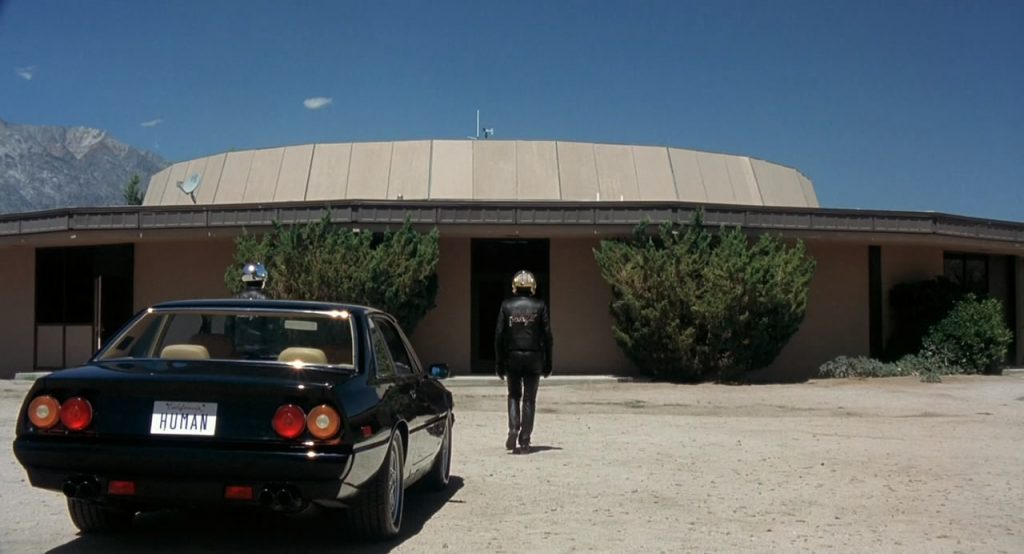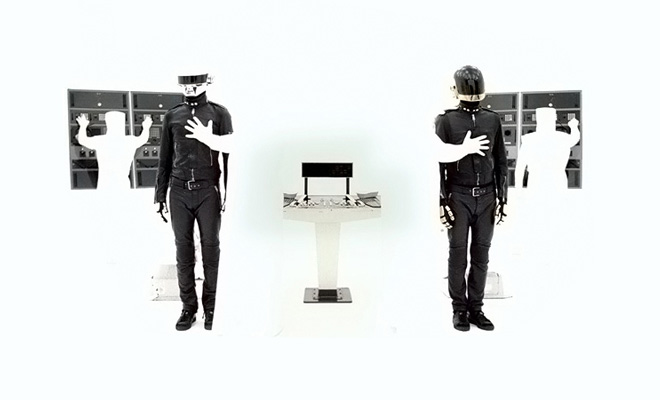Daft Punk’s Electroma
Posted By Buttercup Dew On In North American New RightDaft Punk’s Electroma is a 2007 science fiction drama written and directed by the famous electronic house music duo, Daft Punk (Guy-Manuel de Homem-Christo and Thomas Bangalter), who wear iconic robot outfits as part of their act. Daft Punk formed in 1993 and found success through their 1997 debut album Homework, 2001’s Discovery, and the critically mixed 2005 Human After All. Electroma, released in 2006, is an elaboration on Human After All‘s themes of technology and personal authenticity. The film follows the two Daft Punk robots on their quest to “become human,” one that is painful and existentially crippling.
Electroma is a well-crafted film and unfolds gracefully and unpredictably, but in hindsight, its resolution is seemingly inevitable. In its own way, Electroma expresses adult insight into the nature of being; that fate is partly pre-ordained by character: being a “punk” who cannot accept things stoically leaves one at the mercy of circumstance and contingency. Only by channeling one’s authentic nature — to “become human” — can one participate in history. Despite being both copyrighted and a masterpiece of independent filmmaking, the film (a mere 70 minutes) is freely available on YouTube, making it a small and worthy time investment.
Like Starship Troopers, which contradicts the comfortable life offered Rico with the call of egoless duty, Electroma comments on the tension between the traditional society and the radical individual who wishes to break free from its customs using the tools of commerce, technology, and legal protections. In this, Daft Punk have produced (quite unselfconsciously) a deep critique of Americanism and its neoliberal “pursuit of happiness.” As the film is entirely free of dialogue. it shows that Right-wing critiques of modernity can demonstrated using just character interplay and good acting, unlike the Left or theological commentaries which have to invoke and rely on external texts. To the extent this distinction is true, it shows that Rightist critique is based on real human experience, whereas Leftist critique is based on theories.
The actors who play the Daft Punk duo, using only the nuance of body language, deliver a deep and convincing portrait of disaffected youth who both struggle against modernity and embody it. Given that the movie is populated solely by robots and there is not a single human face, voice, or expression, Electroma is an extremely minimal movie that makes for an outlandish cinematic experience, washing over the viewer in a series of carefully composed shots. Each is set to music, electronic hums and hisses, or silence.
The movie opens with austere shots of rock formations in the howling wind. The wind has worked its way through the sedimentary rockscape affecting different layers unequally, creating what seems to the imaginative eye to be a parade of shuffling human sculptures. The shot cuts to an overhead view of the robots’ car — an immaculate 1987 Ferrari 412, a perfect conveyance of optimistic futurism. The elegance of the 412 and its imitators implies by design that technology will usher in a new and better way of living, that the marriage of luxurious consumerism and technology is the way of the future, the same way the synthesizer is “the sound of the future” (as is stated on Daft Punk’s latest album, Random Access Memories). Having partly damned this outlook with Human After All’s critique tracks “The Prime Time of your Life,” “On/Off” and “The Brainwasher,” it’s a natural progression for the iconic retro car (now just another symbol of wealth) to feature in Electroma.
The Guy-Manuel de Homem-Christo Robot and Thomas Bangalter Robot aka. Hero Robot #1 (gold) and Hero Robot #2 (silver) enter the vehicle. They set off down an empty Californian highway. The directing is matter of fact, and the only noise is an electronic hum in the background. The continuous tracking shot of the vehicle is segmented to show the passage of time. Flames flicker in a flash-forward. They are isolated in the rolling landscape. The hum builds into Todd Rundgren’s upbeat “International Feel,” and the car and robots are re-introduced with more casual and close up shots, as if the two robots are a duo in a buddy-cop movie. The chorus is ecstatic:
“There is more . . .
International feel!
Interplanetary deals!
Interstellar appeal!
Universal ideal!
(Still there is more . . .)
International feel . . .”
Yes, these robots are living the American Dream of universal freedom and liberty! But it’s undercut by the Bangalter Robot’s unsmiling mask. The elation falls away, and the electronic hum returns. The pair enter the outskirts of a small town (in Inyo County, California) and pass a tractor, and the camera lingers long on this reminder of the agricultural life. It is foreign to the two adventurers in their stylish car and leather jackets. They pass into the town, and everyone is a robot of the Bangalter or Homem-Christo variety. They stare in bemusement at the settled people with their sensible lives. Mothers push prams. Office workers converse on the sidewalk. Cops idly watch out for troublemakers. A man reads a newspaper, unhurried, and looks up to see the two Daft Punks staring at him with the contempt of youth. He looks back to his paper, unbothered by their quest for oblivion.
As the robots pass through the town, the viewer watches from their perspective from the passing car and is in turn watched by the townspeople. The sequence is set to Brian Eno’s “In Dark Trees.” The unsettling chugging of the music and its melancholy melody layers the scene with foreboding. The town is bright, spacious, and placid but to the robots’ perception, it seethes with hostility. Is this the self-imposed alienation of youth, that longs to detach itself from the impositions of adulthood? Is it misconstruing what is traditional for what is oppressive, rather than what is proven to be ideal?
The music peaks in intensity as the duo pass a small wedding ceremony being performed in the front of a small white wooden church. People are clapping in celebration. It no doubt fills the robots with horror to see someone invest themselves in the well-being of another of their own kind in familial bonding — this is despite all the robots of the town being exactly like the Bangalter and Homem-Christo robots. It’s possible this deep-seated fear of responsibility the implicitly young robots are harboring is coinciding with something else: the Jewish phobia of an ethnically homogenous community, where self-ghettoizing racial minorities become obvious in their otherness. Bangalter is half-Ashkenazi Jewish on his fathers’ side, conspicuously so next to the French and handsome Homem-Christo.
The robots make it through to the outskirts of the town. Here they arrive at their destination: a low modern circular building with blacked out glass windows. They enter warily and make their way down a long, darkened corridor, into a white operating room occupied by white robots. The room is entirely white and brightly lit, and the white robots are dressed in white so they can only be discerned by their silhouettes in front of computer equipment.
This is the limitless space of the imagination and global commerce where the constraints of nature and circumstance are swept away by technics and purchasing power; it is the operating theatre of the plastic surgeon and the duty-free section of the international airport where everything organic, individual and rooted is cleaned away, leaving only what is designed to appeal to the senses. It is the ultimate fulfillment of the wounded ego that wills towards the cancellation of all that oppose it. Like Shinji in Neon Genesis Evangelion who finds his consciousness and concept of self completely adrift in empty white space, formless and floating (falling?), the Daft Punk robots enter this perfectly inoffensive realm and they find — Nothing; no life, no will, no breath — just the completion of their material desires, technocratic, pure, and sterile.
Flesh colored silicone is cooked, and slowly poured over their helmets. Eye sockets are excavated with scalpels, wigs are produced. Fake eyes and human features are applied with delicacy. The whole affair has the careful choreography of a medical procedure. Despite the inherent ridiculousness of the scene, Daft Punk have been careful to avoid humor deflating the dramatic tension. The rubber masks that are created bear a passing resemblance to Jack Lint’s baby mask in Gilliam’s Brazil — the falsity is uncanny, laughable yet unsettling.
The robots, now resplendent in rubber human features, confidently stride into town to the swaggering blues of “Billy Jack” by Curtis Mayfield. The faces are modeled after Bangalter and Homem-Christo themselves; the implicit message is that Daft Punk would like to leave their stage personas behind and return to being “Human After All,” and the movie is a commentary on this obvious inauthenticity (after all, their creative impulse is genuine) but this is only incidental to Electroma as a whole. The viewer is treated to the townspeople’s stares of confused horror again, this time as the robots proudly reveal themselves to be “human” in the most superficial sense.
However, their dreams of passing as human and of being accepted as equally good as the real thing become quickly unraveled as their rubber masks (like Jazz Jennings’s transgender vagina) fall apart. The blazing heat of the sun causes their once proud and smiling faces to melt, droop, and become morbid and grotesque. The townsfolk run them out, and they hide in a dim public restroom under a flickering light to contemplate their failure. In a testament to Bangalter and Christo’s grasp of film making, the de-masking of the Bangalter and Christo robots is an evocative scene; one experiences pain, paternal affection, and sadness as a sympathetic audience, yet the protagonists remain blank-faced robots. The rubber masks become more convincing through their destruction, and as the smiles sag and flesh ages the expressions change to pained laughter and anguish. Eventually, the Bangalter robot’s “face” falls away entirely, exposing the robot beneath.
If this was a Hollywood movie, the film would have ended several minutes earlier with the triumph of progressivism as a fairy-tale fable that anyone can become anything they want to be. Instead, Daft Punk (in a typical French style) have produced a movie refuting this and examining the self-loathing this fantasy both feeds on and fuels. The Bangalter robot stares into the mirror in despondency and has to be pulled out of his reverie by the embittered Homem-Christo robot. Together, they begin a death march into the desert, abandoning their long-forgotten car and any hope of rejoining society.
The film takes its time as the robots are shown walking through each shot. As they enter the undulating sands of the desert, Linda Perhac’s “If You Were My Man” is set to a sequence where the sweeping curves of the dunes are made to appear like the outlines of a naked woman (eventually, the viewer is treated to a close up). The gentle melody of “If You Were My Man” is from a different era to contemporary pop and the lyrical emphasis; “If you were my man . . .if you were my man . . . How I’d like to treat you, like a man . . .” implies a man is an object of nature, like a rock; that men are born and not “socially constructed.”
What follows is the robots’ realization that death is the only option afforded to them so long as they cling to the notion that their lives are unbearable without “living as” a “human.” Their passion for this frivolity defeats them. Their misery is entirely self-created and satirized with hyperbole (“Miserere” by Gregorio Allegri plays as the robots begin to realize their masks are melting), yet their self-destruction is documented with compassion. Hero Robot #1 assists Hero Robot #2, who has sunk fully into the quicksand of despair, to commit suicide by activating his explosive self-destruct function. He does this without offering the slightest comfort in a way typical to those fixated on their own suffering. Chopin’s Prelude No. 4 in E Minor plays as Hero Robot #1 stumbles shocked towards the gravesite of his disintegrated friend, the music and scene concluding, somewhat tragicomically, with him regarding the leftover scraps of plastic.
Hero Robot #1 then takes a long, contemplative walk into the sunset. Night passes. Eventually, he sets his mind to self-destruct, but he is unable to reach the switch panel on his back. In a way possibly shocking to an audience convinced up until now that these were mere human actors in helmets, he removes his protective helmet revealing a printed circuit board with a set of embedded cameras, proving definitively that he is a robot after all. He smashes his helmet in desperation. Using the curvature of the glass to focus the light of the sun, he ignites his hand to begin self-immolation.
Of course, at any point the robots could have let go of their enthusiasm for passing as human, opened their robo-smartphones, downloaded a meditation course, listened to some smooth jazz, or generally done something or the other to move themselves closer to the realisation that emotions are impersonal things we experience but cannot choose. With this they could have learned that they did not have to kill themselves to escape their emotional pain; they could have simply stopped, accepted that not everything turns out quite how one would like, and started afresh. But Hero Robot #1 is committed, and the plastic foam of his flesh burns away, exposing springs and metal struts for a skeleton.
The final scene is a wonderful display of pyrotechnic and cinematic skill. Hero Robot #1, now just a black figure engulfed in flames, strides through the desert. Through self-destruction he has attained (in a way impossible through trying on the costume of fantasy), full mastery and sovereignty over himself and his body. It is impossible to know whether he is feeling pain, but the confidence and palpable relief in his body language show that he is enjoying the pleasure of spending himself. He has finally learned to enjoy himself just as he is.
If there is anything that can be taken from the misadventures of the robots, it’s that it is better to pursue your own satisfaction rather than trying to achieve a moral or totemic status in the eyes of others. The film demonstrates this has to begin with accepting ones’ fixed nature and the opportunities for growth it provides. If the settled life of the small town is insufficiently radical for you and you prefer instead the futurism of fashy leather jumpsuits and angular cars, there is a place for you in the volcano lairs and Thunderbirds bases of the ethnonationalists. Somehow or another, it is the Daft Punks, the differentiated and dissatisfied individuals who will roll back the hegemony of the white robots (who are the ultimate expression of Americanism, yet who remain concealed, detached, and alien to the American nation). You need not allow frustration to consume you like Hero Robot #1, and can instead find sovereignty over yourself through the route of pursuing individual excellence. Ultimately, you can spend yourself saving the world, enjoying yourself as you are on the way.





